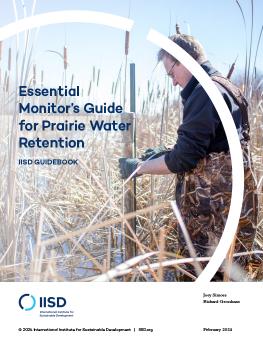
Essential Monitor's Guide for Prairie Water Retention
A water retention project is natural infrastructure that delivers flood, drought, water quality, and other benefits—such as improved habitat, biodiversity, and carbon storage—as a result of managing water and becoming naturalized. Monitoring is necessary to ensure that water retention projects across the Prairies are performing to specification and to track that project performance is upheld over time.
-
Monitoring is necessary to ensure that water retention projects across the Prairies are performing to specification and to track that project performance is upheld over time.
-
Biophysical monitoring allows us to understand the additional benefits that water retention projects provide beyond flood and drought mitigation and the management changes that can be applied to maximize those additional benefits.
-
With the diversity and affordability of tools available today for monitoring water retention, there has never been a better time to begin monitoring a system in your own watershed.
Water retention provides flood, drought, water-quality, and additional benefits, such as improved habitat, biodiversity, and carbon storage, which can be increased through water management and when naturalized. These benefits typically serve as drivers for the implementation of water retention practices within ongoing work to adapt to our changing climate.
Monitoring both water quantity and quality allows us to better understand a site’s performance and the various influences that site design, operation, and maintenance have on enhancing its effectiveness and related co-benefits.
Currently, there is limited long-term data available demonstrating water-quality benefits across a variety of different sites, which we know can vary in performance for several reasons.
Critically, the knowledge gained from monitoring water retention can be used to design sites that
- provide better adaption to our changing climate,
- are optimized to deliver multiple benefits, and
- can be better managed to uphold their performance long after they are constructed
This guidance document aims to make water retention monitoring a more accessible practice from a technical standpoint by demystifying some of the considerations required to get started. It includes a review of various pieces of monitoring equipment, methods of analysis for water quantity and quality, and practical insights and example applications drawn from IISD's own water retention monitoring and modelling experience.
With the diversity and affordability of tools available today for monitoring water retention, there has never been a better time to begin monitoring a system in your own watershed.
Participating experts
You might also be interested in
What Is the UAE Framework for Global Climate Resilience, and How Can Countries Move It Forward?
With the introduction of the new framework for the Global Goal on Adaptation (GGA), COP 28 marked a milestone for adaptation. We unpack key outputs and set out how countries can move forward by strengthening their national monitoring, evaluation, and learning (MEL) systems.
National State of the Environment Report: Uzbekistan
The National State of the Environment Report (NSoER) is a comprehensive document that provides a snapshot of current environmental trends in Uzbekistan's socio-economic development for citizens, experts, and policy-makers in the country of Uzbekistan.
What’s Next After UNEA-6: Why “synergies” is more than a buzzword
In an era marked by escalating environmental challenges and geopolitical tension, the Sixth United Nations Environment Assembly (UNEA-6) called for more cooperation to tackle the triple planetary crisis.
Sustainable Asset Valuation of Parques del Río Norte in Medellín, Colombia
This economic valuation demonstrates the benefits of expanding urban green space in the city of Medellín, Colombia.